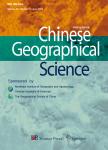Changes in Climate Factors and Their Impacts on Wind Erosion Climatic Erosivity in Farming-pastoral Zone of Northern China
Changes in Climate Factors and Their Impacts on Wind Erosion Climatic Erosivity in Farming-pastoral Zone of Northern China作者机构:School of Geographical SciencesNanjing University of Information Science and TechnologyNanjing 210044China Northeast Institute of Geography and AgroecologyChinese Academy of SciencesChangchun 130102China
出 版 物:《Chinese Geographical Science》 (中国地理科学(英文版))
年 卷 期:2022年第32卷第4期
页 面:665-675页
核心收录:
学科分类:0830[工学-环境科学与工程(可授工学、理学、农学学位)] 07[理学] 0706[理学-大气科学]
基 金:Under the auspices of National Natural Science Foundation of China(No.41901355) National Key R&D Program of China(No.2021YFD1500702)。
主 题:climate factors wind erosion climatic erosivity sensitivity analysis dominant factor climate change
摘 要:Climate change can affect wind erosion power and hence induce changes in wind erosion rates.In this study,the wind erosion climate factor(C-factor),proposed by the Food and Agriculture Organization of the United Nations,was used to assess the impact of changes in climate on wind erosion climatic erosivity.The Mann-Kendall test was employed to detect trends in the C-factor during the period of 1961–2017 in the farming-pastoral zone of northern China.Sensitivity analysis was used to determine the sensitivity of the C-factor to changes in key climate factors.Furthermore,a comparison of the contributions of different climate factors was carried out to understand their impact on changes in the C-factor.The results indicated that most of the surveyed region exhibited decreasing trends in wind speed at a confidence level of 90%,while maximum and minimum temperatures showed increasing trends throughout the study area.As a consequence of decreasing wind speed,the annual C-factor exhibited significant decreasing trends,with a mean slope of–0.58/yr.Seasonal analysis revealed that in most regions,the changes in the C-factor had significant decreasing trends in spring,winter,and autumn,while in more than two-thirds of the study area,no significant change trends in the C-factor were detected in summer at a confidence level of 90%.Sensitivity analysis showed that the C-factor was most sensitive to wind speed,and that the sensitivity coefficients from July to September were much higher than those in other months.Contribution analysis revealed that,for most stations,wind speed(with greater values of sensitivity coefficients)was the dominant factor in the change of C-factor,while for some stations,the minimum temperature made the most contribution to the C-factor’s change due to its dramatic changes during the study period.Although the minimum temperature sensitivity coefficient was the lowest of all the sensitivity coefficients,it is urgent to evaluate the expected impact of minimum temperature due to its possible changes in the future.



